
Latest Breakthrough Applications of RoboSurgeonAI in Healthcare (As of May 2025)
RoboSurgeonAI, an intelligent surgical robotic system integrating AI, high-precision sensing, multimodal imaging, and autonomous control algorithms, is redefining surgical boundaries. This report analyzes its clinical advancements through technological innovations, specialty-specific applications, and cross-regional collaboration models, supported by real-world case studies.
I. Technological Innovations and Functional Advancements
- Multimodal Sensing and Autonomous Decision-Making
- 3D Vision Enhancement: Combines near-infrared fluorescence (NIRF) imaging with deep learning to identify critical structures (e.g., blood vessels, nerves) in real time, reducing intraoperative risks by 30% compared to conventional methods .
- Dynamic Path Planning: AI algorithms adjust robotic trajectories based on tissue deformation (e.g., intestinal peristalsis), achieving submillimeter precision in bowel anastomosis and increasing leak pressure resistance by 30% .
- Force Feedback Optimization: Piezoelectric sensors and haptic algorithms replicate surgeons’ tactile sensitivity, detecting force changes as subtle as 0.1 N during thyroidectomies to prevent recurrent laryngeal nerve injury .
- Cross-Modal Data Fusion
- Preoperative-Intraoperative Integration: The Long Valley AI System generates personalized surgical plans via digital twins, merging CT/MRI data with real-time imaging (e.g., spinal correction with <0.5 mm screw placement error) .
- Multi-Robot Collaboration: Fudan University’s laryngeal surgery system pairs endoscopic robots (visual navigation) with microsurgical robots (glottis resection), improving efficiency by 40% .
- Autonomy Upgrades
- Semi-Autonomous Operations: The Booness AI+ System autonomously ligates blood vessels and sutures mucosa during laryngeal cancer surgery, reducing procedure time to 60% of traditional methods .
- Full Autonomy Trials: The STAR System (Smart Tissue Autonomous Robot) outperforms human surgeons in consistency during intestinal anastomosis in animal trials .
II. Specialty-Specific Applications and Clinical Impact
- Head and Neck Surgery: Revolutionizing Laryngeal Cancer Treatment
- Case Study: In February 2025, Fudan University’s Eye & ENT Hospital performed the first 5G remote glottic cancer resection for a patient in Xinjiang, China.
- Technology: 7-DOF flexible robotic arms via transoral approach (incision <1 cm²) and AI vision (98.7% tumor boundary accuracy).
- Outcome: Swallowing function restored within 48 hours; 85% vocal cord preservation rate (20% higher than conventional surgery) .
- Orthopedics: Precision Spine and Joint Procedures
- Spinal Surgery: The TiRobot Orthopedic System assists in cervical-thoracic-lumbar-sacral pedicle screw placement, reducing radiation exposure by 80% .
- Joint Replacement: Long Valley AI uses CT data to design femoral prosthesis models, achieving <1° cutting angle error and 30% postoperative joint mobility improvement .
- General and Urologic Surgery: Complex Tumor Resection
- Hepatobiliary-Pancreatic Surgery: The Da Vinci Xi System employs fluorescent markers to preserve functional liver volume (>30%) during hilar cholangiocarcinoma resection .
- Prostate Cancer: Hong Kong Polytechnic’s NSRS System reduces post-op urinary control recovery from 3 months to 4 weeks via single-port surgery .
- Neurosurgery: Cellular-Level Precision
- Case Study: The University of Calgary’s NeuroArm integrates 7T MRI and intraoperative ultrasound to track glioma infiltration (50 μm precision) with <0.1 mm resection error .
III. Cross-Regional Collaboration and New Healthcare Models
- 5G Remote Surgery Networks
- Technical Framework: Edge computing nodes (MEC) ensure <10 ms latency; quantum encryption secures data transmission.
- Case Study: In April 2025, West China Hospital performed a 3,000-meter altitude remote partial nephrectomy in Tibet, with robotic arms auto-compensating for air pressure effects .
- Training and Standardization
- AI-Assisted Training: VR simulators with haptic gloves cut skill mastery time by 50% for complex procedures like pancreaticoduodenectomy .
- Global Protocols: ISO/IEC 30130-5 standardizes haptic encoding and safety designs, enabling multinational collaboration .
IV. Future Trends and Challenges
| Direction | Technological Breakthroughs | Clinical Impact |
|---|---|---|
| Full Autonomy | Reinforcement learning decision engines (e.g., STAR 2.0) | Autonomous complex procedures (e.g., CABG) |
| Nanoscale Manipulation | Piezoelectric micro-arms (<1 mm diameter) | Cerebrovascular interventions |
| Multi-Robot Swarms | Endoscopic, microsurgical, and suturing robot synergy | Scarless cancer resection with organ preservation |
| Ethical Accountability | Blockchain for surgical data logging | Legal clarity for AI errors and insurance models |
Conclusion
By 2025, RoboSurgeonAI has evolved from an assistive tool to an autonomous surgical partner, achieving breakthroughs in precision (<0.1 mm accuracy), accessibility (5G remote networks), and standardization (AI-driven protocols). With advancements in nano-robotics, biomaterials, and ethical frameworks, it is poised to redefine the boundaries of “impossible surgeries,” cementing its role as the ultimate collaborator in modern surgery.
Data sourced from public references. For collaborations or domain inquiries, contact: chuanchuan810@gmail.com.




